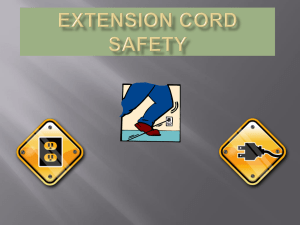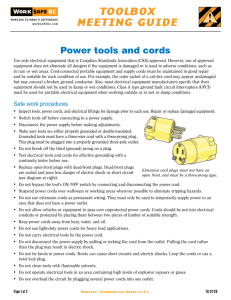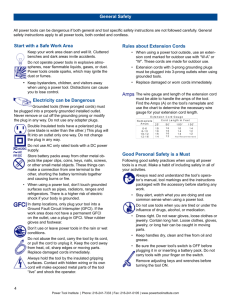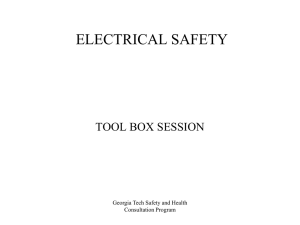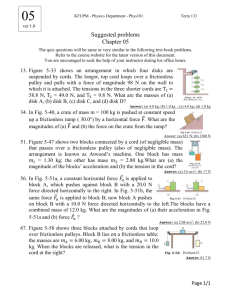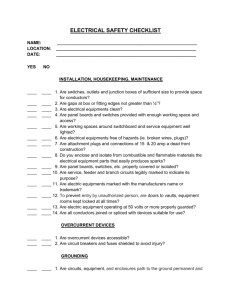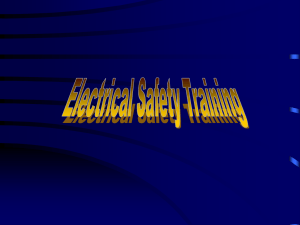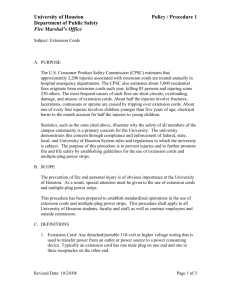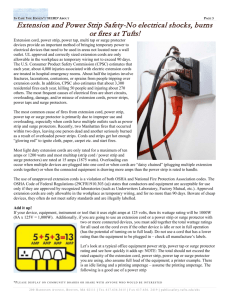Introduction - College of William and Mary
advertisement
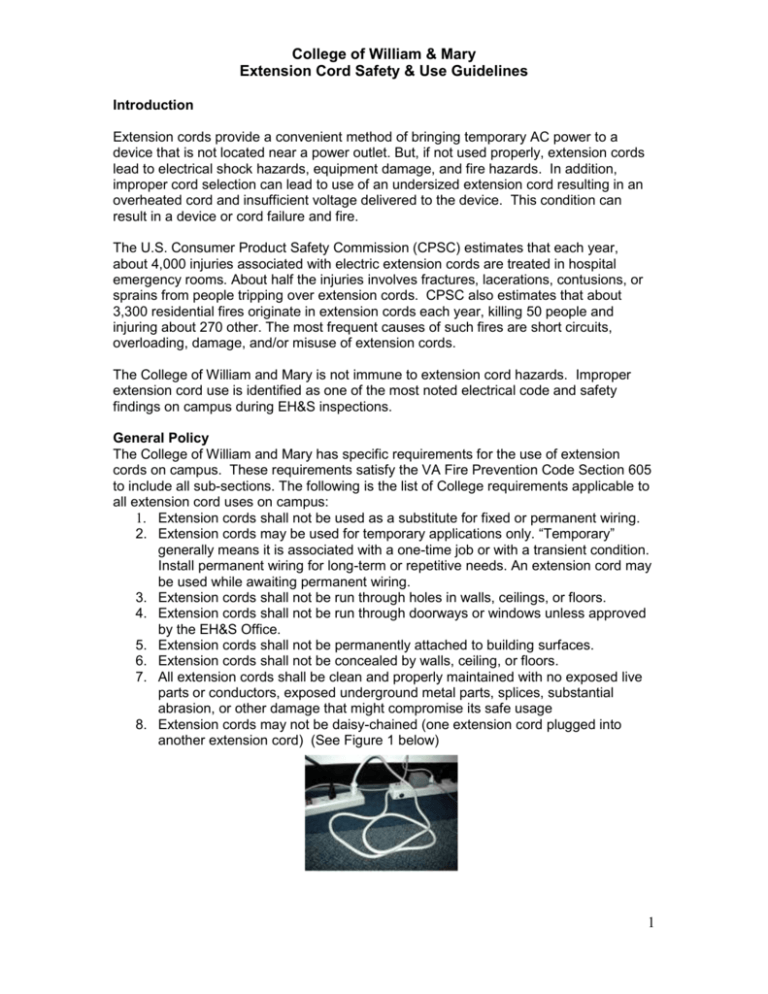
College of William & Mary Extension Cord Safety & Use Guidelines Introduction Extension cords provide a convenient method of bringing temporary AC power to a device that is not located near a power outlet. But, if not used properly, extension cords lead to electrical shock hazards, equipment damage, and fire hazards. In addition, improper cord selection can lead to use of an undersized extension cord resulting in an overheated cord and insufficient voltage delivered to the device. This condition can result in a device or cord failure and fire. The U.S. Consumer Product Safety Commission (CPSC) estimates that each year, about 4,000 injuries associated with electric extension cords are treated in hospital emergency rooms. About half the injuries involves fractures, lacerations, contusions, or sprains from people tripping over extension cords. CPSC also estimates that about 3,300 residential fires originate in extension cords each year, killing 50 people and injuring about 270 other. The most frequent causes of such fires are short circuits, overloading, damage, and/or misuse of extension cords. The College of William and Mary is not immune to extension cord hazards. Improper extension cord use is identified as one of the most noted electrical code and safety findings on campus during EH&S inspections. General Policy The College of William and Mary has specific requirements for the use of extension cords on campus. These requirements satisfy the VA Fire Prevention Code Section 605 to include all sub-sections. The following is the list of College requirements applicable to all extension cord uses on campus: 1. Extension cords shall not be used as a substitute for fixed or permanent wiring. 2. Extension cords may be used for temporary applications only. “Temporary” generally means it is associated with a one-time job or with a transient condition. Install permanent wiring for long-term or repetitive needs. An extension cord may be used while awaiting permanent wiring. 3. Extension cords shall not be run through holes in walls, ceilings, or floors. 4. Extension cords shall not be run through doorways or windows unless approved by the EH&S Office. 5. Extension cords shall not be permanently attached to building surfaces. 6. Extension cords shall not be concealed by walls, ceiling, or floors. 7. All extension cords shall be clean and properly maintained with no exposed live parts or conductors, exposed underground metal parts, splices, substantial abrasion, or other damage that might compromise its safe usage 8. Extension cords may not be daisy-chained (one extension cord plugged into another extension cord) (See Figure 1 below) 1 College of William & Mary Extension Cord Safety & Use Guidelines 9. Relocatable power taps shall be plugged directly into an approved permanently installed receptacle. (See Figure 1 below) 10. Damaged extension cords shall not be spliced or repaired with electrical tape. 11. The molded plug assembly on the extension cord shall not be repaired or replaced as this negates its Underwriter Laboratories(UL) listing. 12. Plug-in multi adapters are prohibited from use on campus. 13. Never use two-conductor extension cords (commonly referred to as “zip cords”). All 120 VAC extension cords used at the College must be three-conductor (grounded) - even if the device it serves uses a two-prong plug. 14. Extension cords should not be used for heat-producing appliances such as coffee pots, toasters, and space heaters. The load from these devices often approaches the circuit capacity, and the added cord length increases the chance of overheating. In addition, the appliance cord to extension cord connection is subject to wear and tear, causing localized heating. 15. All temporary cords shall bear the approval marking of UL or other NRTL. Look for the UL® Mark or equivalent safety standard listing on extension cords you purchase. This means that representative samples of the cord have been tested for forseeable safety hazards for their intended purpose. 16. Store all cords indoors when not in use. Outdoor conditions--especially sunlight-can deteriorate a cord over time. 17. Unplug an extension cord when not in use. The cord will still conduct electricity until it is unplugged from the outlet. 18. Some indoor cords with more than one outlet have covers for the unused openings. Use them; they prevent debris and moisture from entering the unused outlets. 19. Do not use extension cords that are cut or damaged. Touching even a single, exposed strand of wire can give you an electric shock or burn. 20. As a safety feature, extension cords and most appliances have polarized plugs (one blade wider than the other). These special plugs are designed to prevent electric shock by properly aligning circuit conductors. If a plug does not fit, have a qualified electrician install a new outlet. 21. Never file or cut the plug blades or grounding pin of an extension cord or appliance to plug it into an ungrounded outlet. Submit a Facilities 2 College of William & Mary Extension Cord Safety & Use Guidelines Management work request to have an electrician install a new outlet with the proper polarized connections. 22. Keep cords out of work areas. If this situation is unavoidable, secure the cord to the floor with tape or use cord molding. Position cones or other attention-getting warnings to alert passersby. 23. Do not permanently mount power strips to any facility surface. Note that power strips are equipped with mounting slots and hardware. This allows you to temporarily mount the power strip while in use. The power strip should be removed immediately when finished with your work. Figure 1 Offices Extension cord use is prohibited in offices except when used to power holiday decorations. In these instances, the extension cord use should not exceed 90 days and the extension cord should be unplugged and put away immediately after the decorations have been taken down. 3 College of William & Mary Extension Cord Safety & Use Guidelines Relocatable power taps (RPTs) equipped with integral circuit breakers are allowed for use in offices and there is no time restriction on their use. Surge protection devices (SPDs) equipped with integral circuit breakers are allowed for use in office areas where protection of sensitive equipment is desired. Like RPTs, there is no time restriction on the use of SPDs. RPTs and SPDs must be plugged directly into a wall receptacle. Do not connect two or more RPTs, SPDs, extension cords or any combination of the three together in series. This practice is commonly referred to as daisy chaining and it is prohibited. Submit a work request to Facilities Management for installation of a receptacle for the appliance. If an extension cord must be used temporarily, choose the shortest one that will work, and at least one size larger than the appliance cord. Research Labs Power strips shall not be permanently mounted to any facility surface. For equipment racks, test benches, test carts, and similar apparatus, the preferred method of supplying 120 VAC utility power to rack-mounted instruments is with a special raceway power strip specifically designed for permanent installation. Residence Halls Non-fused relocatable power taps and flexible extension cords are prohibited in residence hall rooms. Multi-plug adapters are also prohibited. Relocatable power taps (RPTs) and/or surge protection devices (SPDs) are allowed provided they are grounded and equipped with an integral circuit breaker. RPTs and SPDs must be plugged directly into a wall receptacle. RPTs may be used to provide additional receptacles for student items that require less than 600 watts each. Students should also ensure that they do not exceed the total watts capacity of the RPT. You do this by adding the watts required to power each device you plug into the RPT and then comparing this to the RPT specification on the package or on the back side of the device. SPDs are used when protection of sensitive electronic devices such as a computer is desired. When SPDs are used the same rules above for RPTs apply to SPDs. Improper use of an extension cord or multiplug adapter is considered a violation of the Housing Contract and the College’s Fire and Life Safety Program. Infractions may result in College judicial action for applicable residents. 4 College of William & Mary Extension Cord Safety & Use Guidelines Construction, Maintenance, Repair & Renovations With the wide use of power tools on construction sites, flexible extension cords often are necessary. Because they are exposed, flexible, and unsecured, they are more susceptible to damage than fixed wiring. Extension cords with an equipment grounding conductor must be used at all times. Extension cords must be protected from damage, and not run through doorways or windows where the doors or windows may close, causing damage to the cord. If becomes necessary to run a cord through a doorway or window, then additional means to protect the cord from pinching, scraping and other damage must be provided. Extension cords must be plugged into a circuit protected by a ground fault circuit interrupter on wet or outdoor construction and maintenance sites, or have the ground circuit checked for continuity in an assured grounding conductor program. Detachable multi-tap adapters may not be used on extension cords nor on receptacles. Extension cords should not be run through water or allowed to have connections that may be exposed to puddling water. Extension cords should be a minimum of 16 AWG and be rated for the equipment in use. The following is a guide that might be helpful in selecting the cord: Extension Cord Ampere Rating Wire Size Single Phase Two and Three Conductor Cords Three Phase Cords (Copper) 16AWG 13 amps 10 amps 14AWG 18 amps 15 amps 12AWG 25 amps 20 amps 10AWG 30 amps 25 amps 8AWG 40 amps 35 amps 6AWG 55 amps 45 amps 4AWG 70 amps 60 amps 2AWG 95 amps 80 amps Special Events A Special Event is a one-time or infrequently occurring event outside normal programs or activities of the sponsoring or organizing body. Special Events are temporary and can be held indoors or outdoors. Due to the temporary nature of these events and that they oftentimes involve outside vendors/organizations who are unfamiliar with University electrical safety expectations, the following provides a list of University requirements for extension cord use on campus: 5 College of William & Mary Extension Cord Safety & Use Guidelines All extension cords used on campus for temporary events shall be size #12 AWG minimum, and marked for hard usage. Cords used outdoors shall also be size #12 AWG minimum and marked for wet locations in addition to hard usage. Extension cords used for temporary and/or outdoor events shall have molded connectors at each end (no repaired cords). Extension cords used outdoors shall be plugged into a GFCI protected outlet, contain integral GFCI protection, or be augmented with a GFCI device or “pigtail.” Cords with molded multiple receptacles are acceptable if the total load does not exceed the cord ampacity. Detachable multi-tap adapters may not be used on extension cords nor on receptacles. RPTs and SPDs are not permitted for use outdoors. Extension cords shall be protected to prevent damage and to minimize the trip hazard to event attendees. A UL Listed TVSS may be installed OUTDOORS if evaluated to UL50 with appropriate NEMA Type rating assigned to the device. Types of Cords Extension Cords Extension cords come in either two or three-wire types. Two-wire extension cords should be used to operate one or two small appliances. Three-wire cords are used for outdoor appliances and electric power tools. The third wire on the cord is a ground. This type of cord should never be plugged into an ungrounded electrical outlet. Only grounded extension cords shall be used with power tools. One exception to this is if the power tool is double insulated. Extension cords are intended only for temporary use (generally not to exceed 90 days) with portable equipment with one exception. Extension cords may only be used for: remodeling, maintenance, repair or demolition of buildings and for temporary, holiday needs. The one exception is for research projects in which temporary electrical power and lighting, 600 volts, nominal or less, may be used for the duration of the experimental or developmental work even if it exceeds the 90 day limit and the cord(s) is removed immediately upon completion of the experiment. In addition to the total electrical load, the conditions of use affect extension cord safety. Rated capacity for an extension cord assumes it will be used in an openair and straight configuration. As electric current passes through a wire, electrical resistance causes some voltage drop and heating of the wire. Coiling or winding excess cord length can concentrate this heat and overheat the cord. Similarly, covering a cord with a rug or rag can trap heat and overheat the cord. This trapped heat can damage the cord and lead to a fire. Tying a knot in a cord can have a similar outcome. 6 College of William & Mary Extension Cord Safety & Use Guidelines Relocatable Power Taps (RPT) There are two types of RPTs. The first type is commonly referred to as a “power strip” or “power cord.” Power strips/cords are Listed by Underwriter Laboratories under the product category Relocatable Power Taps (RPT). The second type of relocatable power tap is commonly referred to as a “surge protector” or “surge suppressor.” These devices are provided with transient voltage surge suppression (TVSS) and are Listed by Underwriter Laboratories both as a Relocatable Power Taps (RPT) and as a Transient Voltage Surge Suppressors. Both power strips/cords and surge protectors/suppressors are variations of an extension cord. The main purpose of a power strip is to provide multiple outlets for you to plug-in things that require electricity. Most power strips have an On/Off indicator light. In addition, power strips can be equipped with an integral circuit breaker. The circuit breaker, or fuse, protects the power strip against excessive loads. If you draw too much current because you plug in too many devices or one big appliance like a heater then the fuse or circuit breaker will open. This prevents the power strip from overheating that can result in a fire. All power strips used at the College of William and Mary must be equipped with an internal circuit breaker. Power strips are commonly used in offices to provide multiple receptacles to office equipment. Power strips are also used in the Residence Halls to provide power to student electronic equipment such as computers, printers, cell phones, and Ipod/MP3 devices. They are generally priced under $10. Due to their size, it is often difficult to plug more than two or three AC adaptors into a power strip. Mini extension cords are available to facilitate AC adaptor connections to the power strip receptacles. These mini extension cords are allowed for use on campus. A surge protector looks very similar to a power strip because it also provides multiple outlets, but their main purpose is to provide protection from power surges. Surge protectors should have an indicator light on them that tells you the surge protection component is working. Some also have phone and cable jacks. Surge protectors/suppressors are used to protect sensitive 7 College of William & Mary Extension Cord Safety & Use Guidelines electronic equipment such as computers, monitors, scanners and printers from transient over-voltages. Surge protectors are generally priced between $20$170, depending on the level of surge suppression the unit can provide and the time it takes for the unit to react to a surge. Surge control is important because even small surges or spikes can eventually destroy or affect the performance of expensive electronic equipment. Damage can occur either instantaneously or over time as smaller surges that cause the gradual deterioration of internal circuitry. This gradual deterioration is often referred to as “electronic rust.” Surge protectors are equipped with a metal oxide varistor (MOV) inside the casing. The MOV acts like an electrical sponge because it absorbs dangerous excess voltage and prevents most of it from reaching sensitive equipment. But like a sponge, surge protectors have a limited capacity to absorb. Once the capacity is reached, the unit is no longer protecting the equipment and it should be replaced. Most surge protectors will continue to function as a power strip even though the MOV may have been destroyed by a power spike. There are two possible hazards created when this occurs: 1) If another power surge occurs, it can damage the equipment plugged into the surge protector; and 2) If sufficient voltage passes through the surge protector due to a second power spike, a resistant short may be formed that allows heating to occur inside the unit which can lead to a fire. For these reasons Surge protection devices that do not have any visual or audible indication that the MOV is functioning properly, as well as devices manufactured before 1998, should be removed from serviced and disposed. What Are Surges and Spikes? Surges and spikes are an increase in "normal" electrical line voltage, often caused by a sudden change or demand for more electricity, such as turning on a large appliance, garbage disposal, air conditioner, washer, dryer, etc. A surge typically measures less than 500V and lasts less than two seconds. A spike, by definition, is much shorter in duration - less than one-thousandth of a second (millisecond), but can measure into the thousands of volts. Either type of disturbance can damage electronic equipment beyond practical repair. In addition to change in demand for electricity, bad weather (lightning) and everyday electric utility company switching and maintenance can produce damaging electrical surges on the power line. Shop Made Cords with Receptacle Boxes Among the most common electrical violation is when a multiple receptacle box, designed to be surface mounted, is fitted with a flexible cord and is placed on the floor to provide power to various tools or equipment. These are not permitted 8 College of William & Mary Extension Cord Safety & Use Guidelines and should be taken out of service. Other common problems associated with shop made cords are the use of Romex wire for making up extension cords, the use of the wrong size circuit breakers/overcurrent protection and the use of equipment outdoors that are listed for dry locations only. Flexible Cords Flexible cords and cables are attached to appliances and should not be confused with extension cords that supplement the regular supply cords. Flexible cords can be used as pendants, for the wiring of fixtures, for the connection of portable lamps and appliances, for the connection of stationary equipment that is frequently moved, and to prevent transmission of noise or vibration and allow movement. Flexible cords used for pendants must be provided with strain relief. Generally flexible cords that are designed into machinery are not a problem as long as they are in good condition. Cord Selection Guidelines Extension cords must be rated “HEAVY DUTY” or “EXTRA-HEAVY DUTY” and must be a continuous length. Cords classified as SO, ST, and SJ meet this requirement. 12 gauge 14 gauge 16 gauge Extension cords must be of sufficient currentcarrying capacity to power the device(s) connected to it (See ampacity table below). Long extension cords require increased conductor size to compensate for voltage drop. A good rule of thumb is to use a cord that is one gauge heavier for every 100 feet of additional cord length. Cord Length 0-2 Load Ampere (Current) Rating 2-5 5-7 7-10 10-12 25 ft 16 ga 16 ga 16 ga 16 ga 14 ga 14 ga 50 ft 16 ga 16 ga 16 ga 14 ga 14 ga 12 ga 100 ft 16 ga 16 ga 14 ga 12 ga 12 ga 150 ft 16 ga 14 ga 12 ga 12 ga 200 ft 14 ga 14 ga 12 ga 10 ga 12-15 9 College of William & Mary Extension Cord Safety & Use Guidelines Construction sites require extension cords that are specified for hard usage or extra hard usage. Approved cords may be identified by the word “outdoor” or the letters “WA” on the jacket. Extension cords with molded multiple receptacles are acceptable if the total load does not exceed the cord ampacity. Power strips are designed for a high concentration of low ampere loads. Allowable Cord Uses Extension Cords Extension cords must be of the proper type, size, and voltage and current rating for the intended application. The cord shall not be substantially longer than required for the application. For 120 VAC single-phase service, only unmodified, commercially manufactured extension cords equipped with three-wire plugs and receptacles may be used. In general, these cords shall have molded plugs and receptacles. Multi-tap (“3-way”) extension cords are acceptable. The jackets of commercially manufactured extension cords must indicate approval by Underwriter Laboratories® or another Nationally Recognized Testing Laboratory (NRTL). Extension cords for special applications, such as 208 VAC or 480 VAC threephase service, may be shop-made as required. Only qualified persons may fabricate or repair shop-made extension cords, including the installation of connectors or plugs to the cord. All components of shop-made cords must be of a type approved by an NRTL. For purposes of meeting this requirement, “qualified persons” means a certified electrician employed by William and Mary or subcontracted. At the time of fabrication or repair, shop-made extension cords shall be tested by qualified persons for proper wiring and grounding. Relocatable power taps Bench top use of RPTs on “wet” laboratory benches will be allowed only if they are provided with GFCI protection or the RPT is hung on mounting screws above the benchtop. Ground Fault Circuit Interrupters (GFCI's) The GFCI is a fast acting device that senses small current leakages to ground. Within 1/40 of a second it shuts off the electricity and "interrupts" the current flow. It provides effective protection against shocks and electrocution. GFCI's are required for use on all construction sites and projects. GFCI's are also required when work is conducted in wet or damp locations. If outlets are near sinks, showers or water fountains a GFCI may be required. 10 College of William & Mary Extension Cord Safety & Use Guidelines Disallowable Cord Uses Extension cords Extension cords may not be used in place of permanent facility wiring. Cords shall not be attached to building surfaces or structural members. Cords shall not be permanently concealed in walls, ceilings, or under floors - including raised computer floors. Do not run cords through moisture, tied to over-head pipes, across traveled roads, under carpets, or across areas of high foot traffic. Extension cords may not be run through doors, ceilings, windows, holes in walls, or through hinged door openings in enclosures. This is to prevent “pinch” damage to the cord. If it is absolutely necessary to run an extension cord through a doorway or open window for short-term use, the cord must be protected from damage should the door or window slam shut; it must be removed immediately when no longer in use; and must not be a trip hazard. Do not use extension cords that are frayed, cut, or damaged such that inner conductors show, or that have outer sheaths which have pulled loose from their molded plugs exposing the inner conductors. In particular, do not use a cord that has a bare conductor exposed. Detachable multi-tap adapters may not be used on extension cords nor on receptacles. Cords may not be repaired Relocatable Power Taps (i.e. Power Strips and Surge Protectors) Relocatable power taps are not intended to be series connected (daisy chained) to other relocatable power taps or to extension cords. Relocatable power taps use is intended for indoor use only. Therefore they shall not be used at construction sites and similar locations. Relocatable power taps are not intended to be permanently secured to building structures, tables, work benches or similar structures. Relocatable power taps are not intended to be used as a substitute for fixed wiring. Relocatable power taps shall be plugged directly into a permanently installed receptacle. The cords of relocatable power taps shall not be routed through walls, windows, ceilings, floors or other similar openings. 11 College of William & Mary Extension Cord Safety & Use Guidelines RPTs are never acceptable for the following uses unless they are equipped with GFCI protection: Aquariums To power any water pumping equipment Use in a damp location Use in a cold room Use near a sink or other water source RPTs may never be used in an area that may contain flammable vapors (i.e. solvent storage room, paint cabinet, flammable cabinet, or hazardous waste storage room) even if they are equipped with a GFCI device. These environments require specially rated, intrinsically safe power equipment to prevent explosions. Equipment with a heating element should not be connected to a RPT. Examples include: Hot plate Water bath Heat gun Coffee pot Toaster oven Space heater Refrigerators Copy machines that are not computer printers Office fans Microwave ovens Hair dryers Any other single load exceeding 600 watts Multi-plug adapters Multi-plug adapters are generally not fused. Therefore in many cases the only protection against overload is the circuit fuse which may have a rating higher than the adaptor. Power strips equipped with integral circuit breakers are generally considered a safer alternative to "double adaptors", "two-way plugs", "three-way plugs" or "cube taps" which plug directly into the socket. 12
